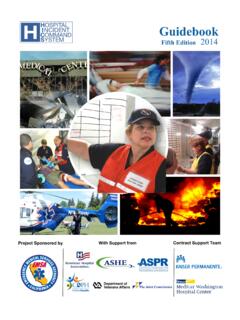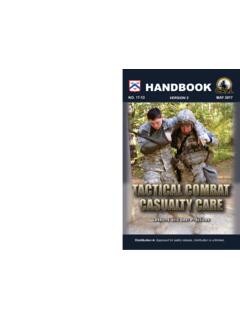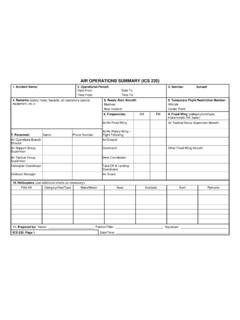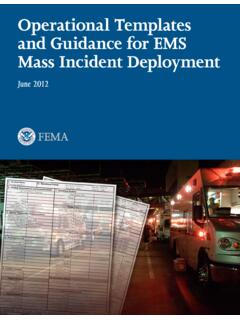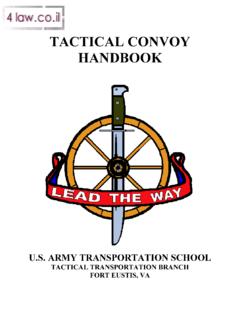Transcription of Tactical Combat Casualty Care - EMSA
1 Tactical Combat Casualty Care quick reference guideFirst editionCopyright 2017 Tactical Combat Casualty CARE(TCCC / TC3)EDITOR:HAROLD R. MONTGOMERY, ATPMSG(RET), ARMYFRANK K. BUTLER, MDCAPT(RET), NAVYSTEPHEN D. GIEBNER, MD, MPHCAPT(RET), NAVYWIN KERR, ATPCURTIS C. CONKLIN, ATPMSG, ARMYDANIEL M. MORISSETTE, ATPMSG, ARMYC opyright Statement:The copyright holder of this publication assigns unlimited royalty-free reproduction licensing exclusively to the United States Government and NATO member governments. Government Printing Offices, specifically Department of Defense installation printing services are authorized to reproduce this publication for use by military copyright holder retains reproduction and royalty licensing for all other individuals or organizations except the Government. No part of the material protected by this copyright may be reproduced or utilized in any form, electronic or mechanical, including photography, recording, or by any information storage and retrieval system, without written permission from the copyright A.
2 REMLEY, ATPSFC, ARMYTRAVIS A. SHAW, NREMT-PMSGT, AIR FORCEJEREMY K. TORRISISCPO, NAVYTHOMAS A. RICH, NREMT-PCMSGT, AIR FORCECONSULTANTS & REVIEWERSC opyright, 2017 by HR MontgomeryISBN: 978-0-692-90697-2 Tactical Combat Casualty CARE(TCCC / TC3)TABLE OF CONTENTSABBREVIATED TCCC 4 COTCCC RECOMMENDED 40DD1380 TCCC 33 Casualty AAR 37 TRIAGE & EVACUATION 34 MEDEVAC REQUEST 35 PLANNING FOR Casualty 52 DRUG QUICK 53 KEY REFERENCES & RECOMMENDED 47 CARE UNDER FIRE 9 Tactical FIELD CARE 10 Tactical EVACUATION CARE 21 TCCC 41 Massi ve Hemorrhage11Ai rway Management12 Respi rati on/Breathi ng13C -Bl eedi ng13C -IV Access14C -TXA14C -Fluid Resuscitation15 Hypothermia Prev16 Monitoring16 Pain Management17 Antibiotics17 Wounds18 Burns18 Splints18 Communications19 CPR19 Documentation19 Prep for Evacuation20 Transition of Care21 Massive Hemorrhage22 Airway Management23 Respiration/Breathing24C -Bleeding25C -IV Access26C -TXA26C -Fluid Resuscitation27 Trauma Brain Injury28 Hypothermia Prev29 Eye Trauma29 Monitoring29 Pain Management30 Antibiotics30 Wounds31 Burns31 Splints31 Communications32 CPR32 Documentation32 Tactical Combat Casualty
3 CARE(TCCC / TC3)FORWARDT actical Combat Casualty Care (TCCC) has saved hundreds of lives during our nation's conflicts in Iraq and Afghanistan. Nearly 90% of Combat fatalities occur before the Casualty reaches a medical treatment facility, it is clear that the prehospital phase of care is the focus of efforts to reduce deaths in Combat . Very few military physicians, however, have had training in this area. As a result, at the onset of hostilities, most Combat Medics, corpsmen, and para-rescue personnel (PJs) in the US Military were trained to perform battlefield trauma care through the use of civilian-based trauma courses that were not designed for the prehospital Combat environment and did not reflect contemporary knowledge in this area. This challenge was met by the Committee on TCCC (CoTCCC) voting members and its many liaison members that collectively comprise the TCCC Working Group. This remarkably eclectic group includes trauma surgeons, emergency medicine physicians, internists, family medicine physicians, operational physicians and physician assistants, Combat medical educators, trauma researchers, pathologists, Combat medical doctrine developers, medical equipment specialists, and Combat medics, corpsmen, and PJs.
4 All of the US Armed Services are well-represented in the group's membership and 100% of the CoTCCC voting members have been to war. The CoTCCC and the TCCC Working Group represents different services, disciplines, and military experiences, all brought to bear on a single goal - reducing preventable deaths on the battlefield. No such group existed when the Twin Towers fell. The US Special Operations Command initially funded the group as a research effort, then ownership of the group was successively assumed by the Naval Operational Medicine Institute, the Defense Health Board, and now the Joint Trau-ma System. This group has taken the TCCC Guidelines as they existed in 2001 and continually updated them throughout the 15 years of war, based on input from the Joint Trauma System Performance Improvement trauma teleconferences, published case reports and case series from the war zones, breakthroughs in military medical research, and new publications from the civilian medical literature that bear on Combat trauma.
5 It has processed a continual steam of input from the battlefield throughout the war years and ensured that battlefield trauma care lessons learned were not just noted, but acted upon. Through the ongoing volunteer efforts of this dedicated group of individuals - which met quarterly throughout most of the war - US Forces have had prehospital trauma care guidelines that were customized for the battlefield and updated continuously based on real-time evaluation of outcomes from ongoing Combat operations. This is the first time in our nation's history that this has occurred. The success of TCCC effort had been well documented. It is a great tribute to all of the members of the CoTCCC and the TCCC Working Group, that it has been able to transcend service and medical specialty differences, process new information expertly, and develop evidence-based, best-practice guidelines that have completely transformed battlefield trauma It is to the Committee on TCCC and all of our valued colleagues in the TCCC Working Group that this TCCC text is dedicated.
6 Our country and its casualties owe you all a profound measure of thanks. Frank Butler, MD CAPT (Retired), MC, USN Chairman, Committee on Tactical Combat Casualty Care Tactical Combat Casualty CARE(TCCC / TC3)ABBREVIATED TCCC GUIDELINES31 JAN 2017 Return Fire and take coverDirect or expect Casualty to remain engaged as a combatant if appropriateDirect Casualty to move to cover and apply self-aid if to keep the Casualty from sustaining additional life-threatening external hemorrhage if tactically feasible:- Direct Casualty to control hemorrhage by self-aid if a CoTCCC-recommended limb tourniquet for extremity hemorrhage - Move the Casualty to coverAirway management is generally best deferred until the Tactical Field Care Management Plan for Care Under FireBasic Management Plan for Tactical Field CareEstablish Security Perimeter IAW Tactical SOPs. Maintain situational Casualties as required. Altered mental status is criteria to have weapons cleared/secured, communications gear secured and sensitive items HemorrhageAssess for unrecognized hemorrhage and control all life-threatening bleeding.
7 Use one or more CoTCCC-recommended limb tourniquets if a CoTCCC approved hemostatic dressing for compressible hemorrhage not amenable to limb tourniquet use. Immediately apply a CoTCCC-recommended junctional tourniquet if the bleeding site is amenable to use of a junctional tourniquet. Airway ManagementUnconscious Casualty without airway obstruction:-Chin lift or jaw thrust maneuver-Nasopharyngeal airway-Place the Casualty in the recovery positionCasualty with airway obstruction or impending airway obstruction:-Allow a conscious Casualty to assume any position that best protects the airway, to include sitting up-Chin lift or jaw thrust maneuver-Nasopharyngeal airway-Place an unconscious Casualty in the recovery positionIf the previous measures are unsuccessful perform a surgical cricothyroidotomy using one of the following:-CricKey technique -Bougie-aided open surgical technique -Standard open surgical technique *Use lidocaine if the Casualty is conscious4 Tactical Combat Casualty CARE(TCCC / TC3)ABBREVIATED TCCC GUIDELINES31 JAN 2017 Basic Management Plan for Tactical Field Care continuedCirculation - IV/IO AccessStart an 18-gauge IV or Saline Lock if indicated.
8 If IV access is not obtainable, use an intraosseous (IO) - BleedingApply a pelvic binder for suspected pelvic fracture and/or severe blunt force or blast injury. Reassess prior tourniquet application: -Expose the wound and determine if a tourniquet is needed; if bleeding is not controlled then tighten tourniquet if the first tourniquet does not control bleeding after tightening, then add a second tourniquet side-by-side with the Limb tourniquets and junctional tourniquets if the following three criteria are met: -The Casualty is not in shock. -It is possible to monitor the wound closely for bleeding. -The tourniquet is not being used to control bleeding from an tourniquets in less than 2 hours if bleeding can be controlled with other means. Expose and use an indelible marker to clearly mark all tourniquet sites with the time of tourniquet application, reapplication, conversion, or a Casualty with progressive respiratory distress and known or suspected torso trauma, consider a tension pneumothorax: -Decompress the chest on the side of the injury at the primary or alternate open and/or sucking chest wounds should be treated by:-Applying a vented chest seal (preferred)-Applying a non-vented chest seal -Burp the wound if indicated for breathing difficultyInitiate pulsoximetry for tension with moderate/severe TBI should be given supplemental oxygen when available to maintain an oxygen saturation > 90%.
9 Circulation - TXAIf a Casualty is anticipated to need a blood transfusion, then administer 1 gram of tranexamic acid (TXA) in 100ml of NS or LR over 10min ASAP but NOT beyond 3 hours post - Fluid ResuscitationAssess for hemorrhagic shock:-If not in shock PO fluids are permissible if Casualty is conscious and can in shock resuscitate with:Whole blood (preferred) orPlasma, RBCs and platelets (1:1:1) orPlasma and RBCs (1:1) orPlasma or if blood products not available,Hextend or Lactated Ringers or Plasma-Lyte-AResuscitate with above fluids until a palpable radial pulse, improved mental status or systolic BP of 80-90 mmHg is present. Discontinue fluids when one or more end points are achieved. Reassess Casualty frequently to check for recurrence of shock. If shock recurs, verify all hemorrhage is under control and repeat fluid resuscitation as Combat Casualty CARE(TCCC / TC3)ABBREVIATED TCCC GUIDELINES31 JAN 2017 Basic Management Plan for Tactical Field Care continuedPenetrating Eye Trauma - If penetrating eye injury is noted or suspected:Perform a rapid field test of visual acuity and document eye with a rigid eye shield (not a pressure patch).
10 Administer Combat Wound Medication Pack if possible and/or administer IV/IM antibiotics per burns should be aggressively monitored for airway status and potential inhalation total body surface area (TBSA) burned to nearest 10%.Cover burned areas with dry, sterile dressings. For burns >20% TBSA, consider placing Casualty immediately in HPMK or other hypothermia prevention Resuscitation (USAISR Rule of Ten):-If burns >20% TBSA, initiate IV/IO fluids ASAP with Lactated Ringers, NS, or Hextend. If Hextend, then no more than 1000ml followed by LR or NS as IV/IO fluid rate = %TBSA X 10ml/per hour for adults 40-80 kg (+100ml/hr for every 10kg above 80kg).-If hemorrhagic shock is present then resuscitate IAW fluid resuscitation in Circulation TCCC interventions may be performed on or through burned PreventionMinimize Casualty environmental exposure and promote heat personal protective gear on if feasible.







